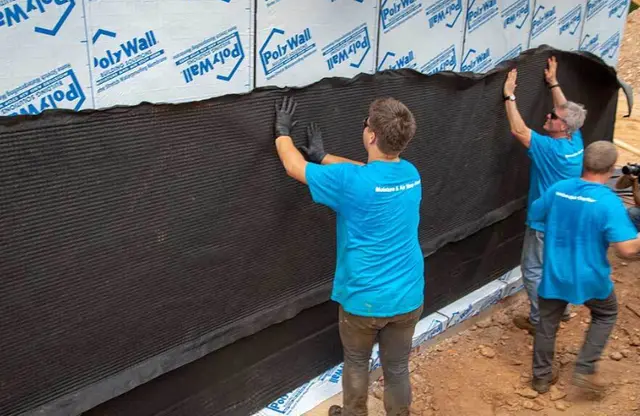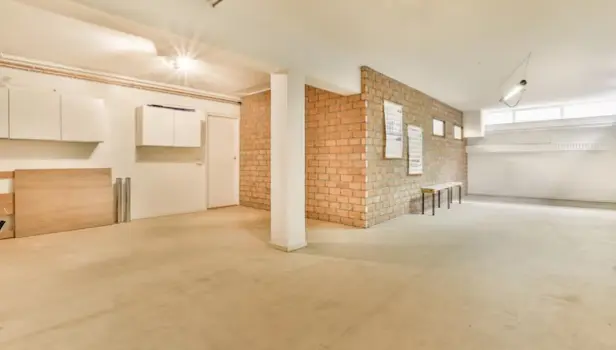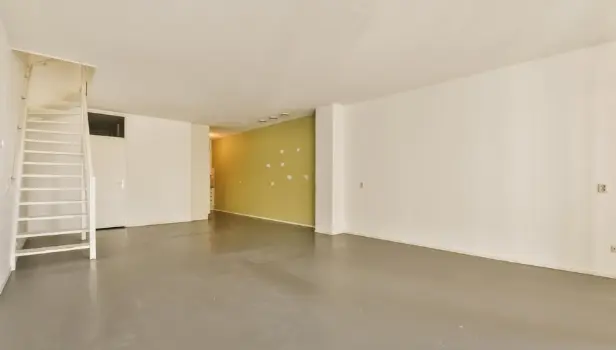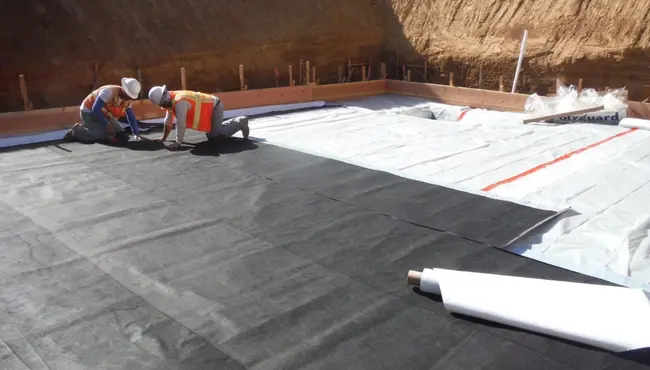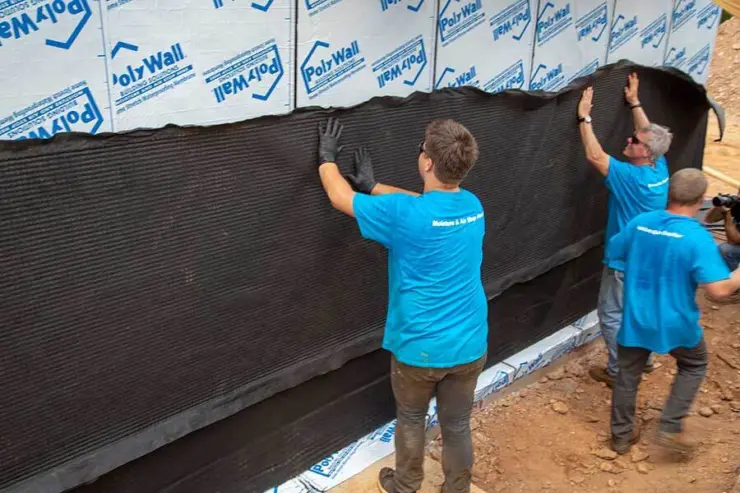
Waterproofing exterior walls is a necessary step in protecting any structure from moisture damage, mold growth, and costly repairs. Whether applied to new builds or older structures, effective waterproofing systems can extend the life of the building by preventing water from penetrating vulnerable areas.
This guide explores several proven methods and products for waterproofing exterior walls, with a focus on practical applications and long-term benefits.
Causes of Water Infiltration in Exterior Walls
Understanding how water infiltrates exterior walls helps identify the right waterproofing solutions. Several factors contribute to moisture issues:
- Hydrostatic Pressure: This pressure occurs when groundwater builds up around a structure, forcing moisture through cracks and weak points, especially in below-grade spaces like basements.
- Capillary Action: Water migrates through small pores in concrete, often carrying salts that cause white deposits (efflorescence) inside walls.
- Poor Drainage Systems: Inefficient drainage causes water to pool near the foundation, increasing the likelihood of infiltration over time.
Addressing these causes requires a combination of proactive waterproofing techniques and reactive solutions to stop ongoing issues.
Best Waterproofing Methods for Exterior Walls
A range of waterproofing techniques can be applied to ensure water does not penetrate exterior walls. Each method suits different structures and environments, so it's essential to select the right one for your building's needs.
Membrane-Based Waterproofing
Membranes are among the most effective ways to protect exterior walls from water damage. They form a strong barrier that prevents moisture from passing through.
- Sheet-Based Membranes: These pre-formed sheets are made of bituminous or polymer-based materials and are ideal for vertical walls and large flat surfaces.
- Liquid-Applied Membranes: Sprayed or brushed onto surfaces, liquid-applied membranes are flexible enough to cover complex shapes and irregularities. They create a seamless barrier, reducing the risk of water penetration in corners or around penetrations. Both membrane types offer strong, long-lasting protection, and the choice between them depends on the wall's structure and exposure to moisture.
Additional Protection with Sealants and Coatings
Sealants and coatings are another essential part of an exterior waterproofing system, filling in cracks and irregularities where water might enter. Polyguard’s liquid-applied solutions are designed to provide additional protection in vulnerable areas, such as around windows and joints. These products ensure that even the smallest gaps are sealed off, complementing larger membrane applications.
Drainage Systems
Drainage systems are critical for diverting water away from the foundation and exterior walls. Effective drainage reduces the hydrostatic pressure that can build up around the structure. Polyguard offers solutions like drainage boards that can be used in conjunction with membranes to provide comprehensive protection. By installing these systems alongside membranes and coatings, you create a multi-layer defense against water infiltration.
To ensure long-lasting protection against water infiltration, Polyguard offers a range of advanced waterproofing products specifically designed to address various structural needs.
Polyguard's Advanced Waterproofing Products
Polyguard offers a range of high-performance products designed to protect exterior walls from moisture damage. Each product addresses specific challenges related to water infiltration, providing a tailored solution for different building types and environments.
Polyguard 650 Membrane
The 650 Membrane offers excellent moisture and vapor protection for a wide range of applications, from foundations to vertical walls. This sheet-based solution is designed to prevent water infiltration through materials like poured concrete, CMU, and wood, making it ideal for structures in moisture-prone areas.
Underseal® PRM™ Membrane
Polyguard's Underseal® PRM™ provides self-healing, puncture-resistant protection, perfect for environments where durability is a top priority. Its strong adhesive properties create a continuous barrier against moisture, making it suitable for high-risk areas like parking garages, basements, and tunnels.
Fluid-Applied Waterproofing Solutions
For surfaces that require a flexible and seamless waterproofing system, Polyguard Stretch Flex offers superior protection. This fluid-applied membrane is designed for surfaces with irregular shapes and areas where standard membranes may struggle. It is cold-applied, which makes it suitable for a variety of temperatures and environmental conditions.
Stretch Flex adheres seamlessly to a range of substrates, providing long-lasting performance in both residential and commercial applications. Its ability to stretch and flex makes it particularly effective in areas prone to movement or vibration, ensuring that the waterproofing layer remains intact over time.
When determining the ideal waterproofing solution, it's important to consider the specific environmental conditions and structural requirements of the project.
Choosing the Right Waterproofing Method
When selecting a waterproofing method, it's important to consider the specific needs of the structure and environment. Membranes, whether sheet-based or liquid-applied, offer long-lasting protection in most environments, while sealants and coatings provide essential reinforcement for areas prone to movement or cracking.
Cost is another key consideration. While some waterproofing systems may have a higher initial cost, the long-term benefits of reduced maintenance and repairs often outweigh the upfront expense. For smaller projects or areas that require targeted protection, liquid-applied membranes offer an affordable and effective solution.
In addition to selecting the right method, it's crucial to evaluate the environmental impact and structural demands to ensure the waterproofing system remains effective over time.
Environmental and Structural Considerations
In addition to performance, long-term durability and environmental factors play a crucial role in selecting waterproofing materials.
- UV Resistance: Exterior walls that are exposed to sunlight require waterproofing materials that can withstand UV radiation. Polyguard’s waterproofing products, especially those for above-grade applications, are designed to resist UV degradation.
- Freeze-Thaw Resilience: In climates with significant temperature fluctuations, materials need to handle expansion and contraction. Polyguard's products are engineered to withstand the effects of freeze-thaw cycles, ensuring that the waterproofing system remains intact over time.
- Sustainability: Polyguard emphasizes eco-friendly solutions with low VOC emissions, making their products suitable for projects prioritizing sustainability.
Explore Polyguard’s Comprehensive Waterproofing Solutions
Protecting your building from moisture damage is a smart investment in its longevity and performance. Polyguard offers a range of waterproofing solutions, from sheet-based membranes to advanced fluid-applied systems, designed to meet the demands of any project. With decades of expertise, we ensure that every product provides reliable, long-term protection for both residential and commercial buildings.
Contact us today for more information.
